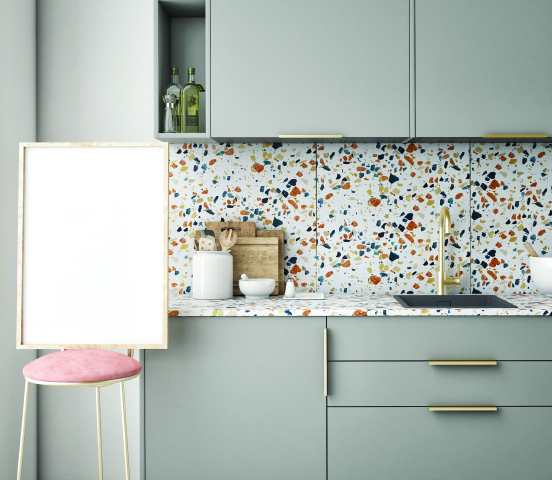Tile adds an eye-catching decorative element to indoor and outdoor spaces. It comes in many colors and patterns that suit various design schemes. With all the different types of tiles, figuring out which kind to use for which application might seem overwhelming.
Whether you’re planning a project or looking for remodel inspiration, here’s a comprehensive guide to tile types and ways you can use them.
Ceramic
The first four types of tile here are all made of clay that has been fired to varying temperatures to make them more durable. Ceramic or stoneware tiles are one of the least expensive types. Clay is a versatile material, easy to customize with shape and color through the production process and easy to maintain.
While ceramic is durable, cuts easily when installing, handles moisture well, and holds up under heavy foot traffic, it is less dense, softer, and more porous than porcelain tile, so it ultimately won’t last as long in constantly damp spaces like the shower.
Porcelain
Porcelain is the most durable and water-resistant of the clay tiles here. However, its hardy composition makes it more challenging to cut. It’s available glazed or unglazed, unglazed being more chip-resistant and long-lasting.

Left to right: National wholesaler Riad Tile carries a wide variety of domestic and imported ceramic and Zellige tiles; terra cotta tiles or a porcelain mosaic will evoke a warm, Mediterranean style in your home.
Terra Cotta
Terra cotta tile has a warm, earthy, rustic appeal in red or brown clay hues. Terra cotta is earthenware, the most porous of clays, which is why it is used unglazed for most plant pots—to help moisture dissipate from the contained soil. But that also means it can suck up stains. When it is glazed, it becomes more water and stain resistant, durable to foot traffic, and bacteria and mold resistant, according to Houzz.
Zellige
Zellige are Terra Cotta tiles made in Morocco, a centuries-old trade where no two tiles turn out alike, according to Riad Tile. Their random color variations and rippling imperfections add a ton of character to your space.
Glass
Glass tile have endless color combinations, opaque and translucent finishes, and a variety of shapes offer a wide range of decorative possibilities, from clean and simple to vintage eclectic charm. You can buy glass tile in individual tiles or as a mosaic collection with mesh backing.
Glass is highly stain-resistant, but you must take care not to scratch it. The material and installation are both expensive.
Marble
Marble is a soft, metamorphic stone. Each slab contains unique color and veining, and much of it originates in Italy, like Carrara marble.
Marble looks luxurious and is easy to work with. However, it stains easily, and acidic cleansers and products can etch it. Its mineral content also makes it subject to rust if not kept consistently dry.
Natural Stone
Beyond marble, various types of natural stone include granite, slate, limestone, and travertine. Natural stone is durable and comes in an array of colors. Tiles made of natural stones can be expensive due to the amount of labor it takes to cut and craft them. You will want sealed stone tiles for surfaces damp surfaces like sink backsplashes or showers.
Cement
To make these tiles, pigmented cement “is hand poured into molds (similar to cookie cutters), molds are removed, then the tiles are compressed under 2,000 pounds of pressure,” according to HGTV. This process yields tiles of different shapes, sizes, and colors, many with a chic matte finish.
Terrazzo
Terrazzo tile is made of small pieces of glass, marble, quartz, and other materials set in concrete. The durable material is long-lasting, and its eclectic color and pattern mix offers a throwback ‘70s vibe. Yet, Terrazzo never loses its trendiness.
Comments are not available on this story.
Send questions/comments to the editors.


